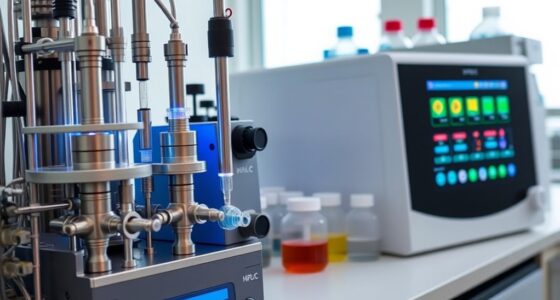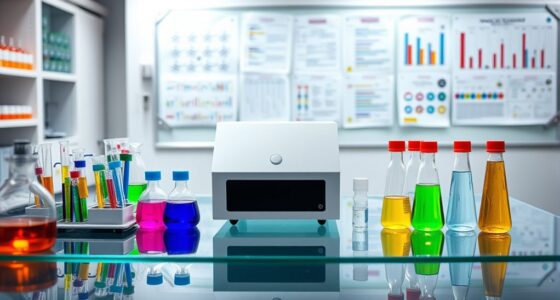Mass spectrometry measures molecules with incredible precision by converting them into charged ions through specialized ionization techniques. These ions are then separated based on their mass-to-charge ratios within the instrument. Detectors record their signals, which are translated into detailed spectra. Accurate calibration and advanced data analysis make sure you can identify and quantify molecules reliably. If you keep exploring, you’ll discover more about how this powerful technology achieves such astonishing accuracy.
Key Takeaways
- Ionization techniques convert molecules into charged particles suitable for precise mass measurement.
- Mass analyzers separate ions based on their mass-to-charge ratios for accurate weighing.
- Detectors generate spectra that display ion intensities, enabling detailed molecular analysis.
- Calibration and advanced algorithms ensure high accuracy in interpreting complex mass spectra.
- Combining these processes allows mass spectrometry to determine molecular weights with astonishing precision.

Mass spectrometry is a powerful technique that allows scientists to determine the weight of molecules with remarkable accuracy. When you use this method, you begin by converting your sample into charged particles through ionization techniques. These techniques, such as electrospray ionization or matrix-assisted laser desorption/ionization, are *essential* because they transform molecules into ions without fragmenting them unexpectedly. Ionization methods significantly influence the quality of your results and should be chosen carefully based on your sample’s characteristics.
Choosing the right ionization method depends on your sample’s nature, but the goal remains the same: producing ions that accurately reflect the original molecules. Once ionized, these charged particles are introduced into a mass analyzer, where their journey is dictated by their mass-to-charge ratio. The mass analyzer separates ions based on their weights, allowing you to measure their precise mass.
Select the appropriate ionization method to generate ions that mirror your molecules accurately for precise mass analysis.
The real power of mass spectrometry lies in the data analysis phase. After ions are separated, detectors record their signals, which are then converted into spectra—visual representations of the ions’ intensities versus their mass-to-charge ratios. Analyzing these spectra requires sophisticated software that can identify peaks, differentiate overlapping signals, and interpret the data with high accuracy. This step is *vital* because the raw data is often complex, especially with mixtures of molecules.
You need to carefully calibrate your instrument and apply algorithms to distinguish between similar ions, ensuring your measurements are reliable. Proper calibration methods are fundamental to ensure the accuracy and reliability of your measurements, especially when working with complex samples. The precision of data analysis directly impacts your ability to determine molecular weights, identify unknown compounds, or analyze complex mixtures.
Understanding how to interpret the spectra is key. You look for the most prominent peaks, which correspond to the most abundant ions, and then use their positions and intensities to deduce molecular weights. In some cases, you might see multiple peaks for a single molecule due to different ionization states or fragmentations.
Advanced data analysis tools help you piece together this puzzle, providing a clear picture of your sample’s composition. The combination of effective ionization techniques and robust data analysis makes mass spectrometry a *vital* tool for weighing molecules with astonishing precision. It allows you to confidently identify, quantify, and characterize molecules in various fields—from pharmaceuticals to environmental science—by transforming complex chemical information into understandable, actionable data.
Frequently Asked Questions
How Does Mass Spectrometry Distinguish Between Isotopes?
When you ask how mass spectrometry distinguishes isotopes, you’re focusing on its ability to detect tiny differences in isotope ratios through mass differentiation.
The device ionizes molecules, then sorts them based on their mass-to-charge ratios. Since isotopes have different masses, mass spectrometry can identify them precisely, revealing variations in isotope ratios.
This process allows you to analyze the subtle differences between isotopes with remarkable accuracy and detail.
Can Mass Spectrometry Analyze Large Biomolecules?
Sure, mass spectrometry can analyze large biomolecules, but don’t expect a simple snapshot. You’ll encounter biomolecule fragmentation, breaking complex structures into manageable pieces, and measuring the mass to charge ratio to piece everything back together. It’s a bit like a molecular puzzle, where even the biggest biomolecules get their secrets revealed—if you’re patient enough to handle the intricate process.
Irony? It’s the tool that’s both delicate and powerful.
What Are Common Sources of Error in Mass Spectrometry?
When using mass spectrometry, you should watch out for common errors like sample preparation issues and magnetic field stability.
Poor sample prep can cause contamination or inconsistent results, while unstable magnetic fields may lead to inaccurate mass readings.
Ensuring your samples are clean and properly prepared, and maintaining stable magnetic fields, helps you improve accuracy and reliability in your measurements.
These steps are key to reducing errors and obtaining precise data.
How Does the Instrument Calibration Affect Measurements?
When you consider instrument calibration, it’s like fine-tuning a delicate instrument to guarantee measurement accuracy. Proper calibration aligns the mass spectrometer’s readings with known standards, helping you avoid subtle errors that could skew results.
If you neglect calibration, your measurements might drift, leading to less reliable data. Regular calibration acts as a safeguard, ensuring your measurements stay precise and trustworthy, ultimately enhancing the quality of your molecular analysis.
Is Mass Spectrometry Suitable for Real-Time Analysis?
You might wonder if mass spectrometry suits real-time analysis. It’s quite suitable because of its speed, allowing you to detect molecules almost instantly.
With rapid data collection, you can monitor changes in samples as they happen, making it ideal for real-time detection.
While some instruments may need optimization for speed, many modern mass spectrometers deliver quick, accurate results, helping you analyze dynamic processes efficiently.
Conclusion
Now you see how mass spectrometry weighs molecules with astonishing precision, revealing their secrets and understanding their structures. It allows you to identify, quantify, and analyze molecules with unmatched accuracy. It helps you explore complex mixtures, distinguish between similar compounds, and uncover new insights. With each measurement, it empowers you to push scientific boundaries, innovate in research, and deepen your knowledge. Mass spectrometry doesn’t just weigh molecules; it transforms how you perceive the tiny building blocks of life.









